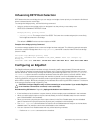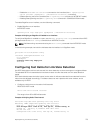
Influencing RSTP Root Selection
RSTP determines the root bridge, but you can assign one bridge a lower priority to increase the likelihood
that it is selected as the root bridge.
To change the bridge priority, use the following command.
• Assign a number as the bridge priority or designate it as the primary or secondary root.
PROTOCOL SPANNING TREE RSTP mode
bridge-priority priority-value
– priority-value The range is from 0 to 65535. The lower the number assigned, the more likely
this bridge becomes the root bridge.
The default is 32768. Entries must be multiples of 4096.
Example of the bridge-priority Command
A console message appears when a new root bridge has been assigned. The following example example
shows the console message after the bridge-priority command is used to make R2 the root bridge
(shown in bold).
Dell(conf-rstp)#bridge-priority 4096
04:27:59: %SYSTEM-P:RP2 %SPANMGR-5-STP_ROOT_CHANGE: RSTP root changed. My
Bridge ID:
4096:0001.e80b.88bd
Old Root: 32768:0001.e801.cbb4 New Root: 4096:0001.e80b.88bd
Configuring an EdgePort
The EdgePort feature enables interfaces to begin forwarding traffic approximately 30 seconds sooner.
In this mode an interface forwards frames by default until it receives a BPDU that indicates that it should
behave otherwise; it does not go through the Learning and Listening states. The
bpduguard shutdown-
on-violation
option causes the interface hardware to be shut down when it receives a BPDU. When
only bpduguard is implemented, although the interface is placed in an Error Disabled state when
receiving the BPDU, the physical interface remains up and spanning-tree drops packets in the hardware
after a BPDU violation. BPDUs are dropped in the software after receiving the BPDU violation. This feature
is the same as PortFast mode in Spanning Tree.
CAUTION: Configure EdgePort only on links connecting to an end station. If you enable EdgePort
on an interface connected to a network, it can cause loops.
Dell Networking OS Behavior: Regarding bpduguard shutdown-on-violation behavior:
• If the interface to be shut down is a port channel, all the member ports are disabled in the hardware.
• When you add a physical port to a port channel already in the Error Disable state, the new member
port is also disabled in the hardware.
• When you remove a physical port from a port channel in the Error Disable state, the error disabled
state is cleared on this physical port (the physical port is enabled in the hardware).
• The reset linecard command does not clear the Error Disabled state of the port or the hardware
disabled state. The interface continues to be disables in the hardware.
• You can clear the Error Disabled state with any of the following methods:
– Perform an shutdown command on the interface.
774
Rapid Spanning Tree Protocol (RSTP)


















